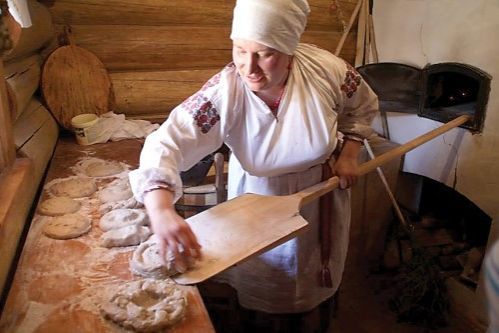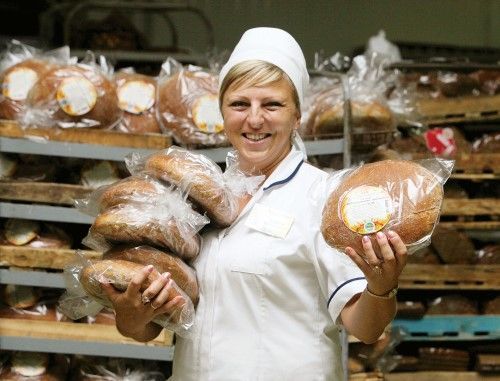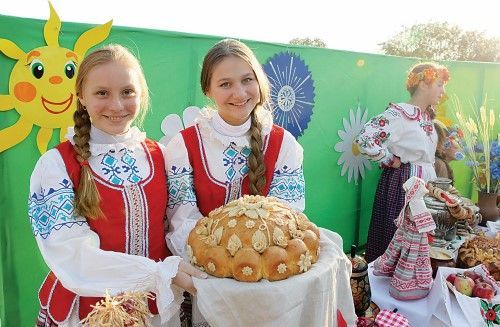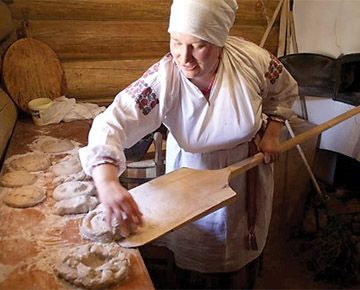Since time immemorial, bread has been appreciated by Belarusians as a symbol of skill and prosperity. Even today, the tradition remains of greeting eminent and important guests with an offering of bread and salt: not only as festive etiquette, but as a sacred ritual symbolising hosts’ hospitality and cordiality. The gesture shows openness to benevolent dialogue, trust and readiness for mutual help and support.

Traditions in bakery are in favor
The offering promises visitors a comfortable stay in a country of material and spiritual riches, where bread dominates. People say: ‘where there is bread, there is song’. Every stage of life is connected with bread and it provides work in fields, grain-processing factories and bakeries — all under state control. Bread has been a traditional food of Belarusians since olden times.
Moreover, by 2015, we should be harvesting at least 10 million tonnes of grain.
Modern Belarusians still consume large quantities of bread, despite adopting a healthier lifestyle. Every supermarket trolley is sure to contain a loaf: the staff of life. This may be a brown rye loaf beneath or a more fragile long white baguette on top of other purchases. Of course, every cafe and restaurant table also offers slices of bread: white and brown.
‘As is the land, so is the bread’: a slice of history
Belarusians show extreme respect for bread, even a reverent attitude, as is ‘in their genes’. The Dudutki Folk Museum, which celebrates ancient national crafts and technologies, located near Minsk, features a unique bakery teaching visitors much about bread. The Dudutki website also explains traditions connected with the process. It should never be roughly broken and even breadcrumbs are valued, being kept from falling on the floor. To tread upon them is seen as quite distasteful. Every woman should traditionally know how to make a loaf and should be careful not to do so when she is in a bad mood, since this can affect its quality.
Traditionally, dough should be always soured by a small piece of old mixture from the bottom of the trough (from the previous batch). On the morning of baking, flour is added to the pre-dough and thoroughly kneaded with the fists. Meanwhile, the oven is heated and carefully swept out with a broom, with the dough formed into a loaf and placed on a special wooden shovel, dusted with flour or cabbage, maple, sweetflag, or horseradish leaves. With the help of the shovel, the loaf is placed into the oven and baked for 1-2 hours, depending on the oven’s temperature. Four to seven loaves were usually baked at once, depending on the size of the family.
The readiness of bread could be checked in various ways: by the appearance of steam or by its ability to ‘jump’ in the hand when held with one and knocked with the other. If a crumb floated in water, it also showed that a loaf was ready, as did clean piercing with a knife or small stick. People might listen for the correct sound on knocking a loaf or touch the loaf to their nose: if it wasn’t too hot, it meant that the moisture had evaporated and the bread was cooked.
Loaves were then laid out to cool, with leaves removed and the crust slightly moistened, to avoid hardening, being covered with embroidered towels.
Workers at Dudutki tell us that, in past times, Belarusians didn’t always eat ‘pure’ bread, prepared only from rye flour. Poor harvests, war and natural disaster obliged them to add other ingredients. Gradovy bread was baked from rye grout (unsifted, being cleared only of husks) while Polovy bread comprised rye flour half mixed with barley, oats, buckwheat or wheat. Potato bread featured the addition of boiled or ground potato, which made it prone to quickly hardening. Meanwhile, in spring and times of poor harvest, people often ate chaffy bread, from oats, barley, wheat or rye chaff rather than flour. It was said that the loaf was easy to travel with but made walking difficult.
Sorrel leaves, orach, acorns and frozen potatoes might be added to rye. An old saying: ‘there’s no trouble in adding orach to bread, only when there is no bread!’
People first began baking wild cereal grain 15,000 years ago. Ubiquitous Wikipedia notes that ancient Egyptians were the first to bake bread from loosened dough by means of fermentation (the basis of modern bread baking). In the 1970s and 1980s, Soviet breads were small in number. Belarusians still prefer mostly rye bread or rye and wheat flour mixes (using dense and liquid ferments). After the collapse of the Soviet Union, the number of varieties grew, and bread making is now a well-developed branch.
Bread unites us
The slogan can be seen on billboards across Minsk, stirring memories connected with bread. Each of us has our own ‘bread’ story. My own reverence for the fragrant ‘crust’ began in childhood, as it does for many. My family always served bread with breakfast, lunch and supper and, as children, we might go walking with a slice. I recall our neighbour’s boy having a thick slice scattered densely with crunchy sugar, to our envy. The sugar darkened directly on the bread, due to water having been first sprinkled. The next day, we all copied him, competing in our methods of eating the delicacy. I wasn’t personally keen, as I told my parents, so my grandmother, laughing, cut a piece and scattered salt and oil instead. I still enjoy this treat, although the vegetable oil of today tastes different from the home-made sunflower-seed oil of Ukraine’s Kharkov District, dense and fragrant.

Alesya Krupoderova, process engineer of “Gomelkhlebprom” bread department, with “Volotovsky” trademark bread, which is in demand
When I was older, I’d be charged with going to the nearest shop to buy bread, on Belgorodskaya Street, at the Belgorodsky shop. It was located along the road to the Russian city of Belgorod. I remember the sour flavour of that fresh, frequently warm bread and the grazed crust, which we ate on the way home. Such an aroma! Similar bread is found in Kletsk and Nesvizh; on visiting these cities, I always buy traditional Nesvizhsky brick-bread, baked from rye and wheat flour. It does not grow mouldy nor harden, showing that it’s made from natural ingredients. Nesvizh has a loaf of breathtaking beauty, made in national style.
If we have bread, we have everything
“Living in Paris is not good, as there is nothing to eat: no brown bread!” complained Alexander Pushkin to his friend, Count Piotr Sheremetiev, visiting France. I can’t help but recall those words when I am abroad on holiday: in Greece, Bulgaria, Egypt or Cyprus. Their white and grey bread is extraordinarily tasty, but there is no brown bread at all. Returning from faraway countries, I always choose rye bread — especially Narochansky. I never grow tired of eating it, or any other rye bread.
Experts in flour-grinding and cereals, bread-baking and macaroni, at the Central Management for Bread Products of the Ministry of Agriculture and Foodstuffs, note that Belarusian bread is made only from natural ingredients. Its research into local bread-buying habits shows that 90 percent of Belarusians prefer rye bread or that made at least in part with rye flour. Nourishing and healthy, it contains proteins and carbohydrates, microelements and major mineral elements, including B vitamins and essential amino acids and fibre. As the Belarusian proverb says: ‘bread strengthens the heart’.
Irina Barantsevich, who heads the department, tells us that rye breads use fermented yeast and various strains of lactic acid bacteria, as well as riced potato, malt, treacle, kvass wort, invert syrup, caraway seeds, linseed and other additives. These create a distinctive aroma and help preserve freshness, without the need for artificial preservatives. Malted rye bread is becoming especially popular, among rural and urban residents, comprising more than 60 percent of bread production volumes.
Manufacture is carried out strictly to meet demand, with ranges gradually expanding in our shops. Up to 2,000 varieties of bakery product are made annually, with around 40 types of bread. The assortment is being ever improved, with less popular bread varieties phased out, replaced by increased volumes of more saleable loaves. For example, in 2014, 500 new types of bread and flour products were developed. Shops are happy to take on board customer suggestions, for passing along to such enterprises as Minskhlebprom, which unites six bread-baking plants across the capital (making it the largest). Their location ensures that high-quality, fresh bread arrives in shops every day.
Narochansky bread… and more
Belarus Segodnya once printed the story of how this distinctive loaf came to be created, in 1986, thanks to Svetlana Zagnetova, the chief technologist of Bread-baking Plant #2 in 2011. It was the first enterprise to master the production of malted rye breads.

Ms. Zagnetova is now in charge of marketing and sales. Hailing from Smargon, she often visited Vilnius as a child, becoming familiar with brown malted rye bread. She tried to bake her own loaf but wanted to make it lighter than that of the Balts. Eventually, she discovered the recipes of elite grades and worked with colleagues to perfect a new version. They added potato, as our grandmothers did, as well as rye malt, treacle and caraway seeds. Thus was Narochansky bread born, enriched with secrets from the best Belarusian village bakers. Colleagues from other Belarusian bread-baking enterprises soon adopted the technique.
Volumes began at just 100 loaves a day, with many refusing to believe it would be popular — especially as it was rather expensive at the time. Nevertheless, the bread quickly gained a following. Ms. Zagnetova also named the bread, choosing from such suggestions as Lugovoy, Ozerny, Lesnoy and Semeiny. It took some time for her to decide upon Narochansky! It retains its place, having been awarded the Grand Prix at the Product of the Year event! Visitors to Belarus also seek it out.
Each Minsk bread-baking plant has own selection of breads: #2 produces Narochansky, Yubilyarny (with its maple leaf), Troitsky, Radzivilovsky and Storozhevsky; #3 has Borodinsky; #4 is known for Baltiysky loaves; #5 has Mayski and Avtomat-Aromat; while #6 produces well-established Sitny. It’s impossible to confuse one with another.
It’s also more common these days for bread to incorporate nuts, dried fruits, linseeds, and sunflower and pumpkin seeds. Besides traditional shaped loaves, you may buy those that are long or round, as well as rolls and buns. Food additives are used in small quantities, to improve the nutritional content. Some loaves are recognisable not just by appearance but by flavour or aroma.

Each region of Belarus has its own preferences. Rye malt breads enjoy demand countrywide, but different enterprises use their own particular recipes, making them unique. Znatny Suvenirny is the bread of Baranovichi bread-baking plant, while Zorka Gandlyu loaves are made at Brestkhlebprom. Vityaz and Dvinsky bread is produced at Vitebskhlebprom, while Izobilny loaves hail from Borisovkhlebprom. Grodnokhlebprom makes Gorodnya bread, while Mogilevkhlebprom creates Detkovsky and Gubernatorsky loaves. Finally, Slaviya bread comes from Gomelkhlebprom.
Innovations and exports
Belarus is now starting to export bread to the USA and Israel, as Ms. Barantsevich notes. She explains, “Our enterprises have mastered the technology of producing frozen goods. It’s labour-consuming and power-consuming but we continue.”
Enterprises under the Ministry of Agriculture and Food have been exporting frozen bread to Israel and America, but mostly to neighbouring regions of the Russian Federation. Over the first 9 months of last year, 5,000 tonnes of frozen bread was supplied to Russia, generating revenue of over $6.1 million. Our bread is natural, with a long expiration date, so it’s not surprising that foreign consumers are keen — including those living in the USA.
All visitors to our republic praise the quality of Belarusian bread, while remarking on the wide assortment and unique flavours. Additives can impart colour but only natural fermentation produces our well-known Narochansky, Bulbash, Dvinsky, Detkovsky, Zoloto Poley and Znatny Suvenir loaves, so loved abroad.
Belarus’ small bakeries comprise just 3 percent of production, with the rest being state run. Of course, there is always room for improvement. Irina believes that some buyers will always make traditional choices (Narochansky, Borodinsky, Darnitsky and Verkhnedvinsky loaves) but others are eager to try something new.
By Valentina Zhdanovich
Useful facts about bread
In days gone by, bread made from plain wheat flour was called a ‘pie’ and affordable only be those with money to spare. Peasants ate bread from rye flour with various additives. As traditional Belarusian families had many children, the mother of the household would often bake 10-15 loaves, weighing 6 pounds (about 2.5kg) each, using 1-1.5 poods of flour (more than 16kg).
There’s no secret to making dough but Belarusians made it in a barrel, pouring a little flour into warm water and leaving it to turn sour and ferment. More flour was then added to make flexible dough, as for pancakes. The barrel was covered by a towel and left overnight in a warm place, so that it rose and thickened by morning, ready for kneading. Some was always left at the bottom of the barrel, to help the next batch. Every loaf was baked unleavened, and without salt, which was expensive.
Even today, domestic bakeries use natural fermenting processes for bread, which can be time and labour-consuming. Leningradsky and Ivanovsky techniques are popular, while thermophilic lactic-acid bacteria are added.
Many Belarusians bake bread at home, with the help of bread-baking machines, which are convenient, with unquestionable advantages, allowing us to experiment with recipes: using tomato juice instead of water for instance or mixing in fried onions with bacon.
The average Belarusian is thought to eat nearly 160g of bread daily, although this doesn’t include loaves made in restaurants and cafes, which increase in number every year. Bread and bakery products in Belarus are made on an industrial scale: by the Ministry of Agriculture and Food’s 52 enterprises (56-57 percent); by Minskhlebprom (17-18 percent); and by Belkoopsoyuz (18 percent) and small, private manufacturers.
(Based on AiF newspaper data in Belarus)











